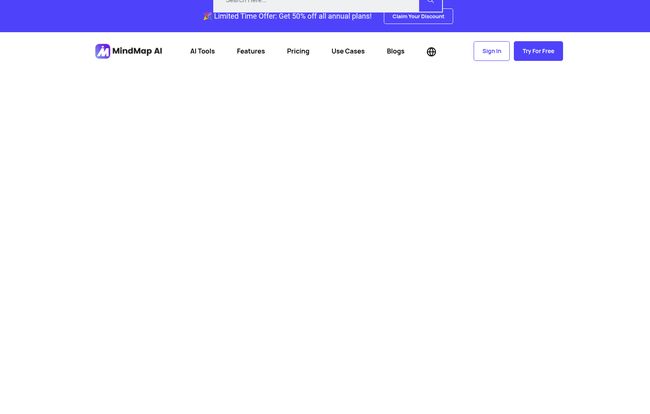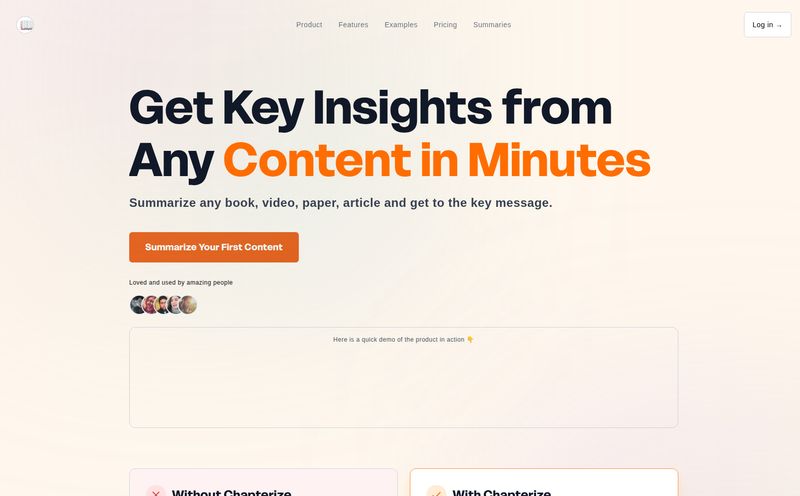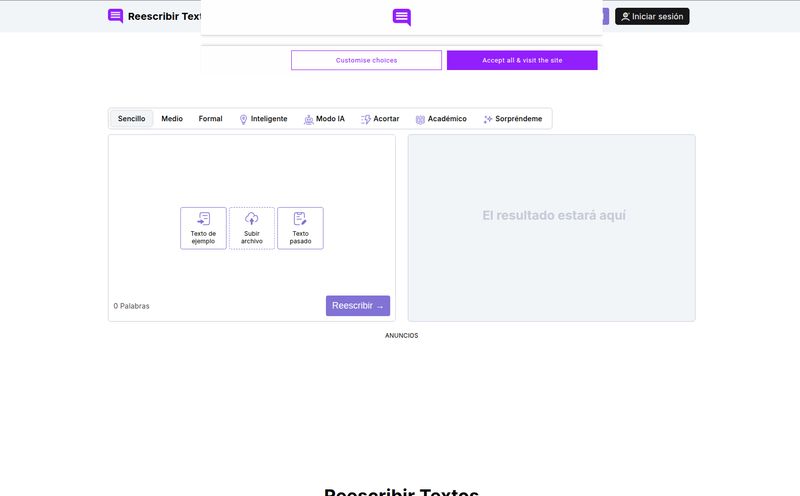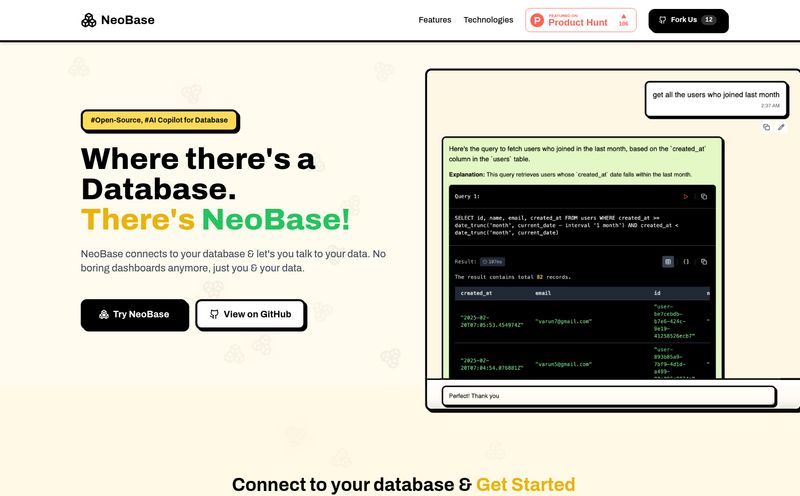We've all been there. Staring at a blank screen, the cursor blinking mockingly, while a storm of half-formed ideas rages in your head. It’s a mess in there. You've got brilliant concepts tangled up with grocery lists and that song you can't get out of your head. Trying to untangle that into a coherent plan can feel like trying to knit a sweater with spaghetti.
For years, my go-to has been mind mapping. A big sheet of paper, a pen, and just letting it all flow. But even that has its limits. It's static. It's messy. And transferring it to a digital format? Ugh. A total chore.
So, when I kept hearing whispers about MindMap AI, a tool that claims to do the heavy lifting for you, my professional curiosity was piqued. Another AI tool promising to change everything? Sure, Jan. But this one felt a little different. It wasn't just about writing content; it was about structuring thought itself. So I rolled up my sleeves and dove in. And I have some thoughts.

Visit MindMap AI
So, What is MindMap AI, Really?
Imagine you could take a dense, 50-page PDF report, a rambling audio recording of a meeting, or even just a chaotic brain-dump of text, and tell a smart assistant: "Make sense of this for me." That's pretty much the core promise of MindMap AI. It’s an AI-powered mind mapping tool that doesn't just give you a canvas, it helps you paint the picture.
It uses AI to instantly generate structured, logical mind maps from a whole bunch of different sources. It’s less of a blank whiteboard and more of a thinking partner. A partner that can read, listen, and organize faster than you can say “synergy.” (Don't worry, I won’t say it again).
The Features That Actually Caught My Eye
Every new tool throws a list of features at you. But which ones actually make a difference in your day-to-day grind? Here’s what stood out to me.
The Magic of AI-Powered Generation
This is the main event. The ability to feed it information and watch a mind map bloom into existence is, I admit, pretty cool. I tested this with a few old blog posts and a particularly dense marketing report. The results were impressive. It correctly identified the main topics, sub-points, and the relationships between them. It’s not perfect, but it gets you 80% of the way there in about 10% of the time. For someone in the content and SEO world, this is a massive time-saver for outlining articles or deconstructing a competitor's strategy.
Your Personal AI Copilot for Brainstorming
Beyond just generating maps, MindMap AI has an interactive chat feature they call the 'Copilot'. This is where it gets fun. You can literally have a conversation with your mind map. You can ask it to expand on a certain point, suggest new branches, or even play devil's advocate. For example, I prompted it with "New SEO strategy for a local coffee shop" and then used the copilot to ask things like "What are some low-budget content ideas?" and "Suggest 5 blog post titles based on this map." It felt less like using a tool and more like a genuine brainstorming session.
It Eats All Kinds of Media for Breakfast
This is a big one. Most mind mapping tools are strictly text-based. MindMap AI, on the other hand, can create maps from text, PDFs, CSVs, images, audio, and even video. The idea of dropping a YouTube link to a conference talk and getting a summarized mind map of the key takeaways is... well, it’s a game-changer for learning and research. The file size limits are tied to your subscription plan, but the capability itself is a huge plus.
Let's Talk Money: The MindMap AI Pricing Structure
Alright, the all-important question: what's this going to cost me? The pricing is... flexible. Which is both good and a little confusing. They've got everything from a free-forever plan to one-time payment lifetime deals. Plus, I saw a banner on their site for 50% off annual plans, so keep an eye out for that!
| Plan | Price | Key Features & Credits |
|---|---|---|
| Free | $0 / month | 100 monthly AI credits, unlimited manual projects, basic export options. Great for testing the waters. |
| Basic | $7.49 / month or $3.74 / month (billed yearly) | 2,000 monthly AI credits, text/image/PDF/audio/video to map, larger file limits. |
| Pro | $14.99 / month or $7.49 / month (billed yearly) | 5,000 monthly AI credits, even larger file limits, priority support. |
| Lite (Lifetime) | $129 one-time | A bulk of 100,000 AI credits that never expire. Includes pro-level features. |
| Plus (Lifetime) | $199 one-time | A bigger bulk of 200,000 AI credits that never expire. |
| Ultimate (Lifetime) | $399 one-time | A massive 500,000 AI credits that never expire. |
Personally, as someone who despises monthly subscriptions, those lifetime deals (LTDs) are seriously tempting. You pay once and get a huge bucket of credits. For a freelancer or a small agency, it could be a very smart investment.
The Good, The Bad, and The Publicly Shared
No tool is perfect. It's important to go in with your eyes open. Here’s my no-fluff breakdown.
The Good Stuff
The efficiency is undeniable. It dramatically cuts down the time from raw idea to structured plan. The AI Copilot is more than a gimmick; it’s a genuinely useful partner for overcoming creative hurdles. The ability to use different media formats makes it incredibly versatile, way beyond typical mind mappers.
The Not-So-Good Stuff
First, the whole system runs on AI credits. Every time you ask the AI to do something, it costs you credits. While the plans are reasonably generous, it's still something you have to monitor. Second, the file size limits on lower tiers might be a bit restrictive for power users. But the biggest red flag for me, and this is a big one, is the sharing policy. When you share a mind map, it becomes publicly accessible and cannot be made private again. Yikes. This makes it a complete non-starter for any sensitive or proprietary business information. You have to be very careful what you share.
Who is This Actually For?
So, who should click that 'Try For Free' button?
- Students: Absolutely. Turning lecture notes, textbook chapters, or research papers into study guides? This is a dream tool for that.
- Content Creators & Marketers: Yes. Brainstorming campaign ideas, outlining long-form content, and analyzing competitor materials becomes so much faster.
- Project Managers: It's great for initial project scoping and breaking down complex tasks into a visual hierarchy.
- Corporate Strategists: With a huge caveat. Given the public sharing issue, I would not use this for internal strategy or confidential data. For non-sensitive brainstorming, it’s fine.
Frequently Asked Questions about MindMap AI
Is MindMap AI completely free to use?
Yes, there is a free plan! It gives you 100 AI credits per month, which is enough to try out the core features and see if it fits your workflow before committing to a paid plan.
What exactly are these AI credits?
Think of them as tokens for using the AI. Generating a mind map from a document, asking the AI Copilot a question, or expanding a node all consume a certain number of credits. Your plan determines how many you get per month or, in the case of lifetime deals, in total.
How is this different from tools like Miro or XMind?
Traditional tools like Miro or XMind are fantastic digital whiteboards or manual mind mappers. They give you the canvas. MindMap AI is different because it actively helps you generate the content for the canvas using AI. It's about automation and idea generation, not just manual organization.
Is my data private on MindMap AI?
This is the critical question. Your projects are private to your account until you share them. According to their policy, once you generate a shareable link for a mind map, that map becomes public and indexed by search engines. So, for personal study or non-sensitive brainstorming, it's fine. For confidential business planning, I would not use the sharing feature.
Can I export my mind maps?
You bet. You can export your creations as high-quality PNG, SVG, or PDF files, and even as Markdown text, which is super handy for bloggers and developers. The flexibility here is a definite plus.
My Final Verdict on MindMap AI
So, is MindMap AI the revolutionary tool it claims to be? For a certain type of user, it gets pretty darn close. It has successfully unclogged my creative drain on more than one occasion in the short time I've used it.
It’s not going to replace human strategic thinking, but it acts as an incredible accelerator. It’s a powerful assistant that can organize, summarize, and suggest ideas at a speed you just can't match manually. The interface is clean, the AI is surprisingly smart, and the multi-format input is a killer feature.
Just be keenly aware of the credit system and, I can't stress this enough, the public-by-default sharing model. If you can work within those constraints, especially for academic, personal, or non-sensitive content creation, MindMap AI could very well become your new favorite brainstorming partner. I, for one, am keeping that lifetime deal page bookmarked.



